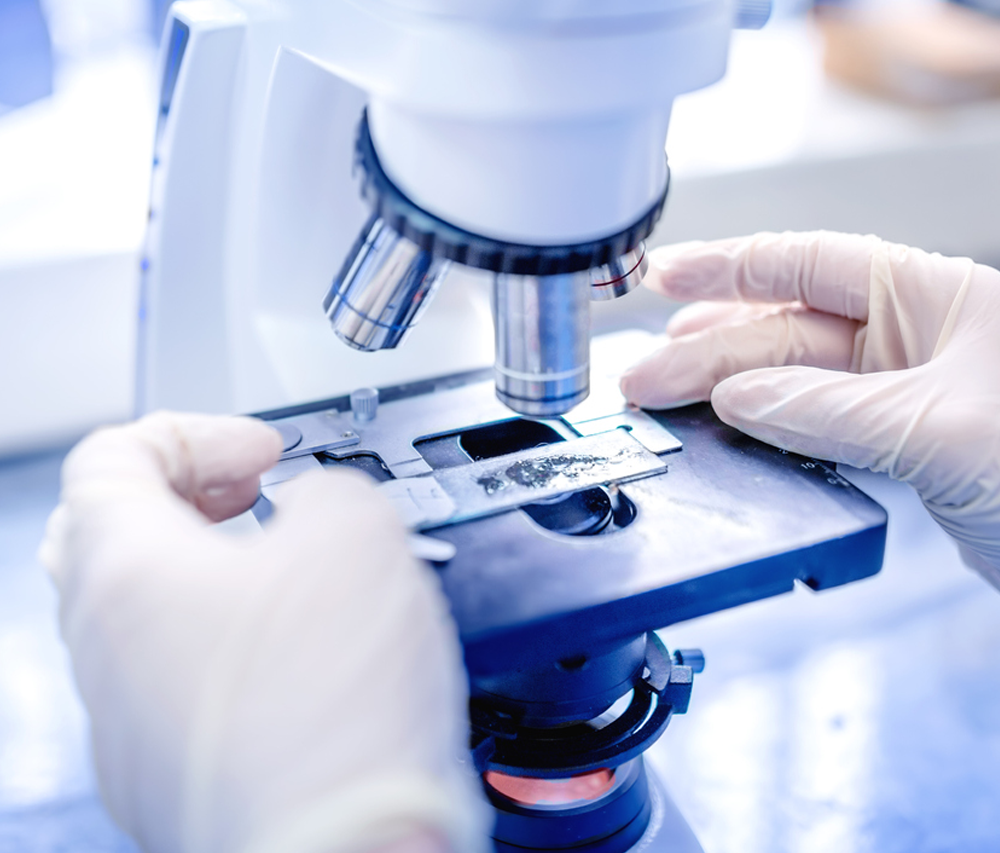Biopsy Services
A biopsy is a procedure to remove a piece of tissue or a sample of cells from your body so that it can be analyzed in a laboratory. If you’re experiencing certain signs and symptoms or if your doctor has identified an area of concern, you may undergo a biopsy to determine whether you have cancer or some other condition.
Biopsy Procedures
Bone marrow biopsy
Your doctor may recommend a bone marrow biopsy if an abnormality is detected in your blood or if your doctor suspects cancer has originated in or traveled to your bone marrow.
Bone marrow is the spongy material inside some of your larger bones where blood cells are produced. Analyzing a sample of bone marrow may reveal what’s causing your blood problem.
Bone marrow biopsy is commonly used to diagnose a variety of blood problems — both noncancerous and cancerous — including blood cancers, such as leukemia, lymphoma, and multiple myeloma. A bone marrow biopsy may also detect cancers that started elsewhere and traveled to the bone marrow.
During a bone marrow biopsy, your doctor draws a sample of bone marrow out of the back of your hipbone using a long needle. In some cases, your doctor may biopsy marrow from other bones in your body. You receive a local anesthetic before a bone marrow biopsy in order to minimize discomfort during the procedure.
Endoscopic biopsy
During endoscopy, your doctor uses a thin, flexible tube (endoscope) with a light on the end to see structures inside your body. Special tools are passed through the tube to take a small sample of tissue to be analyzed.
What type of endoscopic biopsy you undergo depends on where the suspicious area is located. Tubes used in an endoscopic biopsy can be inserted through your mouth, rectum, urinary tract or a small incision in your skin. Examples of endoscopic biopsy procedures include cystoscopy to collect tissue from inside your bladder, bronchoscopy to get tissue from inside your lung and colonoscopy to collect tissue from inside your colon.
Needle biopsy
During a needle biopsy, your doctor uses a special needle to extract cells from a suspicious area.
A needle biopsy is often used on tumors that your doctor can feel through your skin, such as suspicious breast lumps and enlarged lymph nodes. When combined with an imaging procedure, such as X-ray, needle biopsy can be used to collect cells from a suspicious area that can’t be felt through the skin.
Needle biopsy procedures include:
- Fine-needle aspiration. During fine-needle aspiration, a long, thin needle is inserted into the suspicious area. A syringe is used to draw out fluid and cells for analysis.
- Core needle biopsy. A larger needle with a cutting tip is used during core needle biopsy to draw a column of tissue out of a suspicious area.
- Vacuum-assisted biopsy. During a vacuum-assisted biopsy, a suction device increases the amount of fluid and cells that is extracted through the needle. This can reduce the number of times the needle must be inserted to collect an adequate sample.
- Image-guided biopsy. Image-guided biopsy combines an imaging procedure — such as X-ray, computerized tomography (CT), magnetic resonance imaging (MRI), or ultrasound — with a needle biopsy.Image-guided biopsy allows your doctor to access suspicious areas that can’t be felt through the skin, such as abnormalities on the liver, lung, or prostate. Using real-time images, your doctor can make sure the needle reaches the correct spot.
You’ll receive a local anesthetic to numb the area being biopsied in order to minimize the pain.
Skin biopsy
A skin (cutaneous) biopsy removes cells from the surface of your body. A skin biopsy is used most often to diagnose skin conditions, including melanoma and other cancers. What type of skin biopsy you undergo will depend on the type of cancer suspected and the extent of the suspicious cells. Skin biopsy procedures include:
- Shave biopsy. During a shave biopsy, the doctor uses a tool similar to a razor to scrape the surface of your skin.
- Punch biopsy. During a punch biopsy, the doctor uses a circular tool to remove a small section of your skin’s deeper layers.
- Incisional biopsy. During an incisional biopsy, the doctor uses a scalpel to remove a small area of skin. Whether you receive stitches to close the biopsy site depends on the amount of skin removed.
- Excisional biopsy. During an excisional biopsy, the doctor removes an entire lump or an entire area of abnormal skin. You’ll likely receive stitches to close the biopsy site.
You receive a local anesthetic to numb the biopsy site before the procedure.
Surgical biopsy
If the cells in question can’t be accessed with other biopsy procedures or if other biopsy results have been inconclusive, your doctor may recommend a surgical biopsy.
During a surgical biopsy, a surgeon makes an incision in your skin to access the suspicious area of cells. Examples of surgical biopsy procedures include surgery to remove a breast lump for a possible breast cancer diagnosis and surgery to remove a lymph node for a possible lymphoma diagnosis.
Surgical biopsy procedures can be used to remove part of an abnormal area of cells (incisional biopsy). Or surgical biopsy may be used to remove an entire area of abnormal cells (excisional biopsy).
You may receive local anesthetics to numb the area of the biopsy. Some surgical biopsy procedures require general anesthetics to make you unconscious during the procedure. You may also be required to stay in the hospital for observation after the procedure.
Biopsy analysis and results
After your doctor obtains a tissue sample, it’s sent to a laboratory for analysis. The sample may be chemically treated or frozen and sliced into very thin sections. The sections are placed on glass slides, stained to enhance contrast and studied under a microscope.
The results help your doctor determine whether the cells are cancerous. If the cells are cancerous, the biopsy results can tell your doctor where the cancer originated — the type of cancer.
A biopsy also helps your doctor determine how aggressive your cancer is — the cancer’s grade. The grade is sometimes expressed as a number on a scale of 1 to 4 and is determined by how cancer cells look under the microscope.
Low-grade (grade 1) cancers are generally the least aggressive and high-grade (grade 4) cancers are generally the most aggressive. This information may help guide treatment options. Other special tests on the cancer cells also can help to guide treatment choices.
In certain cases, such as during surgery, a pathologist examines the sample of cells immediately and results are available to your surgeon within minutes. But in most cases, the results of your biopsy are available in a few days. Some samples may need more time to be analyzed. Ask your doctor how long to expect to wait for your biopsy results.
Source:
https://www.mayoclinic.org/diseases-conditions/cancer/in-depth/biopsy/art-20043922
Our Services
Our all-encompassing health care services ensure you receive the correct diagnosis and treatment for any oncological condition.

Biopsy Services
Diagnostic Testing

Dietary Coaching

Infusion Services

Prevention and Screenings

Radiation Therapy and Technology

Research and Clinical Trials

Support Services

Testimonials
Your Health Starts Here
Flexible appointments
We are happy to serve you.
Same Day Appointments are Available. We also offer 24/7 chronic care management.

